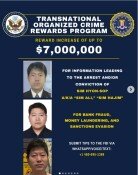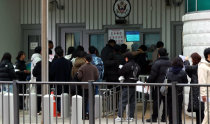U.S. speeds up austerity
U.S. speeds up austerity
Posted January. 07, 2022 07:39,
Updated January. 07, 2022 07:39
The forecast that the U.S. Fed would begin in earnest taking austerity measures earlier than expected, as early as March, by raising benchmark interest rate increased volatility of the South Korean financial market and exchange rate. Stock prices plunged both at home and abroad, and the won-dollar exchange rate rose to 1,200 won on Wednesday. Concerns over the taper tantrum are also surfacing, which was resulted from the Fed’s draining of excess liquidity in the market injected into emerging markets in the wake of the 2008 global financial crisis.
The Fed is expected to raise the current near-zero interest starting March up to 1 percent within this year. The motives behind the Fed’s expediting the timing for austerity is the need to curb down inflation, with the consumer price index having soared to a record high in 40 years. An asset bubble that some evaluate as “more maddening than during the dot come bubble in the late 1990s” should no longer be left as it is.
The U.S.’s interest rate hike may spark capital outflows from the Korean stock market with foreign investors offloading shares, which would inevitably have adverse effects on stock prices and drive up exchange rates (depreciation of the value of won relative to dollar). An increase in exchange rate may enhance export competitiveness, but under the current circumstances where global supply chains are being disrupted, prices of imported consumer goods, raw materials, and energy will increase at a faster rate. In fact, South Korea’s exports reached a new record in December 2021, but exports were outnumbered by imports, resulting in deficits in trade balance in 20 months. An increase in import prices will in turn lead to price rise, adding pressures on people’s livelihoods, shrinking in consumption, and hampering economic recovery.
Rising debt is a bigger problem. The Monetary Policy Committee under the Bank of Korea is planning to raise benchmark interest rate that currently stands at 1 percent up to 1.75 percent within this year. This would in turn increase debt repayment burden on those who purchased home by taking out a mortgage to the maximum amount, which contributed to household debt higher than the country’s GDP, and the self-employed with excessive debts that resulted from business restrictions from COVID-19. When a loan moratorium extended for the self-employed and small business owners ends in March, the self-employed and SMEs may go bankrupt in succession.
Being on the brink of austerity, households must refrain from taking out excessive loans to make investments in apartments and stocks. The self-employed and SMES must also tighten their belts and secure liquidity to prepare for austerity measures. In particular, the government must actively manage a rapid surge in inflation, interest rates, and exchange rates―the three major economic indices―and take a decisive stance to requests from political circles for excessive fiscal spending.







